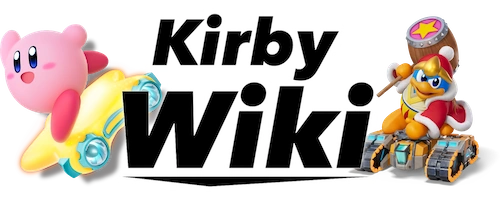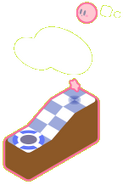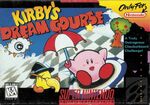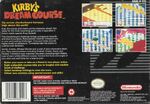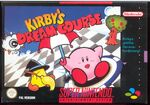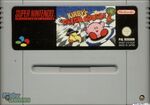(Wording, HAL golf history) Tag: Visual edit |
|||
| Line 20: | Line 20: | ||
{{Quote|This golf-inspired game pitted one to two players against eight outlandish courses. To complete a hole, players had to defeat every enemy on the field and drop ball-shaped Kirby into the cup. Fewer shots meant a higher score. On top of planning each shot's power and trajectory, players had to make smart use of Kirby's 10 Copy Abilities.|Summary|''[[Kirby's Dream Collection: Special Edition]]''}} |
{{Quote|This golf-inspired game pitted one to two players against eight outlandish courses. To complete a hole, players had to defeat every enemy on the field and drop ball-shaped Kirby into the cup. Fewer shots meant a higher score. On top of planning each shot's power and trajectory, players had to make smart use of Kirby's 10 Copy Abilities.|Summary|''[[Kirby's Dream Collection: Special Edition]]''}} |
||
| − | '''''Kirby's Dream Course''''', known in Japan as カービィボウル (''Kābī Bōru'', meaning '''''Kirby Bowl'''''), is a |
+ | '''''Kirby's Dream Course''''', known in Japan as カービィボウル (''Kābī Bōru'', meaning '''''Kirby Bowl'''''), is a ''[[Kirby (series)|Kirby]]-''themed golf game for the Super Nintendo Entertainment System (SNES) that was originally released in Japan on September 21, 1994, and was then later released on February 1, 1995 in North America and on August 24, 1995 in Europe. An early spin-off title in the ''Kirby ''series, and Kirby's first appearance on the SNES, it was developed as a collaboration between [[HAL Laboratory]] and [[Nintendo]] EAD. <ref>https://www.mobygames.com/game/snes/kirbys-dream-course/credits</ref> |
| − | Although the graphics are entirely 2D, ''Kirby's Dream Course'' is notable for being the very first ''Kirby'' game with 3D gameplay and physics. It is a golf-style game with [[Copy Ability|Copy Abilities]] and elements |
+ | Although the graphics are entirely 2D, ''Kirby's Dream Course'' is notable for being the very first ''Kirby'' game with 3D gameplay and physics. It is a golf-style game with [[Copy Ability|Copy Abilities]] and other fantastical elements. As suggested by its Japanese title, the game can also be said to contain elements of bowling, with the enemies serving as "pins." There are eight courses in the game and each one has eight holes. The game has a scoring system which awards Gold, Silver and Bronze medals for each level. There are special unlockables in the game once a player gets enough medals, including extra courses. In the single-player mode, the player eventually meets and battles a [[Mecha Dedede|robotic version]] of [[King Dedede]] at the top of the map. |
''Kirby's Dream Course'' was also re-released on the Wii, Wii U, and New Nintendo 3DS Virtual Consoles. Additionally, it is one of the 21 games packaged with the Super NES Classic Edition system. |
''Kirby's Dream Course'' was also re-released on the Wii, Wii U, and New Nintendo 3DS Virtual Consoles. Additionally, it is one of the 21 games packaged with the Super NES Classic Edition system. |
||
| Line 82: | Line 82: | ||
== ''Special Tee Shot'' == |
== ''Special Tee Shot'' == |
||
{{main|Kirby's Dream Course/Special Tee Shot}} |
{{main|Kirby's Dream Course/Special Tee Shot}} |
||
| − | ''Kirby's Dream Course'' was based on the gameplay and engine of ''Special Tee Shot'', an originally unreleased SNES game made by Nintendo EAD. Before its planned release, it was decided that the game would be redesigned into a spin-off of the ''Kirby'' series, and HAL Laboratory was entrusted with the project. ''Special Tee Shot'' would eventually be released in its original form via the Satellaview peripheral in Japan only. |
+ | ''Kirby's Dream Course'' was based on the gameplay and engine of ''Special Tee Shot'', an originally unreleased SNES game made by Nintendo EAD. Before its planned release, it was decided that the game would be redesigned into a spin-off of the ''Kirby'' series, and HAL Laboratory was entrusted with the project. (HAL Labs already had extensive experience with golf games through their long-running ''Hole in One ''series, which may have influenced Nintendo's selection of them.) ''Special Tee Shot'' would eventually be released in its original form via the Satellaview peripheral in Japan only. <ref>[[nintendo:Special_Tee_Shot|http://nintendo.wikia.com/wiki/Special_Tee_Shot]] </ref> |
==Trivia== |
==Trivia== |
||
*This game contains many sound effects from ''[[w:c:earthbound:EarthBound|EarthBound/Mother 2]]'' as both games were being developed side by side at HAL Laboratory. |
*This game contains many sound effects from ''[[w:c:earthbound:EarthBound|EarthBound/Mother 2]]'' as both games were being developed side by side at HAL Laboratory. |
||
| − | *Remnants from ''Special Tee Shot'' can be found unused in the Japanese version of ''Kirby's Dream Course''.<ref>http://wiki.rustedlogic.net/Kirby%27s_Dream_Course#Special_Tee_Shot_Connection</ref> |
+ | *Remnants from ''Special Tee Shot'' can be found unused in the Japanese version of ''Kirby's Dream Course''.<ref>http://wiki.rustedlogic.net/Kirby%27s_Dream_Course#Special_Tee_Shot_Connection</ref> Though not normally accessible, they were removed for international releases. |
*This was the first game in the [[Kirby series|''Kirby'' series]] to have any kind of age rating. The ESRB rating scale didn't exist when the [[Kirby's Dream Land|first]] [[Kirby's Adventure|three]] [[Kirby's Pinball Land|games]] were released. |
*This was the first game in the [[Kirby series|''Kirby'' series]] to have any kind of age rating. The ESRB rating scale didn't exist when the [[Kirby's Dream Land|first]] [[Kirby's Adventure|three]] [[Kirby's Pinball Land|games]] were released. |
||
*This is the first game to feature an in-game depiction of [[Kirby's house]], though only in the Japanese version. |
*This is the first game to feature an in-game depiction of [[Kirby's house]], though only in the Japanese version. |
||
Revision as of 05:36, 20 December 2017
| “ | This golf-inspired game pitted one to two players against eight outlandish courses. To complete a hole, players had to defeat every enemy on the field and drop ball-shaped Kirby into the cup. Fewer shots meant a higher score. On top of planning each shot's power and trajectory, players had to make smart use of Kirby's 10 Copy Abilities.” |
| — Summary • Kirby's Dream Collection: Special Edition |
Kirby's Dream Course, known in Japan as カービィボウル (Kābī Bōru, meaning Kirby Bowl), is a Kirby-themed golf game for the Super Nintendo Entertainment System (SNES) that was originally released in Japan on September 21, 1994, and was then later released on February 1, 1995 in North America and on August 24, 1995 in Europe. An early spin-off title in the Kirby series, and Kirby's first appearance on the SNES, it was developed as a collaboration between HAL Laboratory and Nintendo EAD. [4]
Although the graphics are entirely 2D, Kirby's Dream Course is notable for being the very first Kirby game with 3D gameplay and physics. It is a golf-style game with Copy Abilities and other fantastical elements. As suggested by its Japanese title, the game can also be said to contain elements of bowling, with the enemies serving as "pins." There are eight courses in the game and each one has eight holes. The game has a scoring system which awards Gold, Silver and Bronze medals for each level. There are special unlockables in the game once a player gets enough medals, including extra courses. In the single-player mode, the player eventually meets and battles a robotic version of King Dedede at the top of the map.
Kirby's Dream Course was also re-released on the Wii, Wii U, and New Nintendo 3DS Virtual Consoles. Additionally, it is one of the 21 games packaged with the Super NES Classic Edition system.
Story
The plot of Kirby's Dream Course varies depending on the version. In the Japanese version, a short cutscene establishes the story if the player waits on the title screen. This cutscene was removed altogether in the North American localization. Instead, the North American instruction manual describes roughly the same story but with more details and slightly different events. A number of elements were added to justify or explain why certain things occur in the game, such as enemies dropping stars when Kirby defeats them.
Instruction manual 
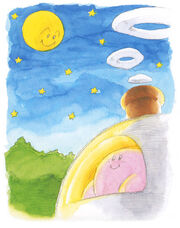
Kirby's Dream Course illustration
After the Fountain of Dreams was returned to normal, the inhabitants of Dream Land continue their peaceful lives. They grow attached to the beautiful stars in Planet Popstar's night sky. One night, they all look up into the sky to gaze at them. To their dismay, they discover that the thousands of stars have all vanished. Though some inhabitants try to remain optimistic, their hope fades over the following nights as the stars do not return.[5] Deeply saddened, their distress grows rapidly. Eventually they stop eating delicious meals, having pleasant dreams, laughing, and smiling.
In the midst of the turmoil, a rumor spreads that King Dedede is the one responsible for the stars' disappearance, having stolen them to keep their beauty all to himself. Kirby sets out to recover Dream Land's stars and teach Dedede a lesson. The hero heads to the king's floating castle, which is rigged with traps and secured by servants, each of which holds a missing star.[6]
=
After a lazy day, Kirby hopes to have a good dream in the starlight. He notices that all the stars in the sky are gone, save for one. All the following nights were the same way. Worried, Kirby takes a telescope and gaze into the night sky. As he does, he finds King Dedede floating by in the distance, pulling the last star behind him. Dedede realizes the pink puff is watching and speeds off, dropping the star. It lands on the ground near Kirby. The hero promptly jumps on the star and pursues the king at his floating castle.[7]
Gameplay
The player uses Kirby as a ball. Kirby must hit all of the enemies on the course, the last enemy becoming a hole which must then be sunk into. There is a health meter with vitality represented by Tomatoes; these are lost each time Kirby makes a shot or if he hits spikes, and can be gained back by sinking the ball and defeating enemies. If the player runs out of Tomatoes, Kirby loses a life; after losing all lives, the player is sent to repeat the failed course from the beginning. Copy Abilities can be gained by hitting certain enemies. Freeze, UFO, Hi-Jump, Wheel, Spark, Parasol, Needle, and Stone. These abilities can be used to achieve the goal more effectively depending on the situation of the player. There is a video tutorial system in the game which explains 20 techniques.

Single-player Mode
The levels can have hazards such as water, sand, spikes, and moving floor traps. Some levels have switches that, if passed over by Kirby, will toggle these hazards off or on. Additionally, there are boost tiles and warp tiles, which are usually bigger.
Each course has a different par total number of strokes for awarding bronze, silver and gold medals, which are represented as leaderboard records set by different Kirby enemies.
Copy Abilities
Burning |
Freeze |
Hi-Jump |
Needle |
Parasol |
Spark |
Stone |
UFO |
Tornado |
Wheel |
Two-Player Mode

Two-Player Mode

The Course Selection Screen in Two-Player Mode
In two-player mode, the second player uses Keeby as a ball. Both players can play on one of four different multiplayer-specific courses, each with different main enemies: Whispy Woods, Mr. Shine & Mr. Bright, Kracko, and Gordo. In this mode, the players are set against one another in a competition to see who can get more stars. These can be obtained by defeating enemies and passing through or sinking into the hole; players can also steal each others' stars by passing through them. Stars obtained by player one (Kirby) will be colored pink, while the stars obtained by player two (Keeby) will be colored yellow. The player who gets the most stars after clearing all levels of the respective course is the winner. An enemy drops one star, a hole grants two.
The health meter is not represented by tomatoes in this mode; instead, they are changed into pink and yellow colored bars, respective to each player. If a player runs out of health, their respective character will get dizzy and fall asleep dreaming of food, losing a turn; after the turn has passed, the character will wake up and automatically get their health replenished by 4 bars. Colliding with the other player will bounce them away and drain one of their health bars. Although players cannot be permanently KOed in this mode, attacking the other player is a viable strategy to gain stars, especially to knock them into a pit or remove them from the vicinity of a hole.
There is a switch that only appears on this game mode: the Sun and Moon switch. When hit for the first time, Mr. Shine will appear onscreen and switch the level's background to nighttime while simultaneously switching the number of stars acquired by one player with the other. If the switch is hit for a second time, Mr. Bright will appear onscreen and can effectively revert all effects. This switch can only be hit three times, after which it turns grey and stops working. Being a highly desirable switch for the player with less stars, it usually is located in hard-to-reach and dangerous spots.
Notably, the courses accessible in the two-player mode are missing some of the special environmental gimmicks present in the single-player mode, such as teleporters and conveyor belts. They were likely omitted due to difficulties in handling the physics of collisions between two players using these gimmicks, and balance issues that would arise from them.
Music
| Main article: Kirby's Dream Course/Music |
Piracy
Kirby's Dream Course is the first Kirby game to contain multi-level anti-piracy measures. In this case, should the game be detected as a copy (checking for an unusual amount of SRAM that would indicate the use of a cartridge copier), it will hang the game at a warning screen. It also hangs the game if a copy of the North American version is played on a PAL console, stating that it is not compatible.
Should that be bypassed, it will cause game behavior to change and make the game itself harder. In single-player mode, Kirby cannot recover health from defeating enemies and does not earn a 1UP from getting a hole in one. If Kirby manages to complete a course, the game crashes and deletes all save data. If Kirby runs out of lives, the Continue option is barred, and selecting the Game End option deletes all save data. In two-player mode, recovering from sleep causes Kirby or Keeby to regain only one point of health rather than four.[8] These changes were likely designed to fool software pirates into thinking that they had bypassed the game's copy protection, while rendering any illegitimate copies they may have made nearly unplayable.
Special Tee Shot
| Main article: Kirby's Dream Course/Special Tee Shot |
Kirby's Dream Course was based on the gameplay and engine of Special Tee Shot, an originally unreleased SNES game made by Nintendo EAD. Before its planned release, it was decided that the game would be redesigned into a spin-off of the Kirby series, and HAL Laboratory was entrusted with the project. (HAL Labs already had extensive experience with golf games through their long-running Hole in One series, which may have influenced Nintendo's selection of them.) Special Tee Shot would eventually be released in its original form via the Satellaview peripheral in Japan only. [9]
Trivia
- This game contains many sound effects from EarthBound/Mother 2 as both games were being developed side by side at HAL Laboratory.
- Remnants from Special Tee Shot can be found unused in the Japanese version of Kirby's Dream Course.[10] Though not normally accessible, they were removed for international releases.
- This was the first game in the Kirby series to have any kind of age rating. The ESRB rating scale didn't exist when the first three games were released.
- This is the first game to feature an in-game depiction of Kirby's house, though only in the Japanese version.
- In the Music Room in Kirby and the Rainbow Curse, Kirby's Dream Course is represented by an image of a hole.
- When playing amiibo tap: Nintendo's Greatest Bits, if the player taps an amiibo product to the Wii U GamePad, there is a chance that he/she will unlock a demo of Kirby's Dream Course.
- In two-player mode, if a player falls off the course while in nighttime, a Flapper will pick up the player instead of a Bronto Burt, as it normally happens.
- The Bronto Burt in this game appears to be a sprite edit of the yellow ball character from Special Tee Shot.
- If the player falls off the stage, Kirby/Keeby will lose two health bars/tomatoes.
- It's possible to fall in the hole in Two-Player Mode, but not get the two stars that appear above the hole; this can only happen when the other player is at the edge of the hole.
- If a Kirby rolls on an edge with inclines descending on both sides, Kirby will eventually fall to the right instead of staying on the edge.
- The commercial for this game was only aired in Japan, and the advertisement was referencing Galileo Galilei, and his famous experiment on gravity. In this experiment, Galileo used two spheres of different weight and dropped them from The Leaning Tower of Pisa. In the commercial however, instead of using two spheres, he used a sphere and Kirby. When Kirby was falling to the earth's surface, he pulled out a parasol, allowing him to slowly fall towards the ground. This event adds some humor to the commercial because according to the results of this experiment, both spheres hit the ground at the same time.
- The game has a very unique save system in the single-player mode, where the player can draw a low-resolution, black-and-white picture with the D-pad to personalize their save file and represent themselves in the score rankings. A pencil and eraser tool are present, as well as a number of Kirby-themed stamps that can be applied to the drawing, such as a Maxim Tomato. This drawing system was originally present in Special Tee Shot.
- For a brief time during the development transition, Kirby's Dream Course was known as Kirby's Tee Shot.
Artwork
Box Art
Media
Logo
External links
References
- ↑ Gamespot
- ↑ Nintendolife.com
- ↑ Gamnesia
- ↑ https://www.mobygames.com/game/snes/kirbys-dream-course/credits
- ↑ Kirby's Dream Course instruction manual (p. 2 and 3)
- ↑ Kirby's Dream Course instruction manual (p. 4 and 5)
- ↑ Intro cutscene
- ↑ YouTube
- ↑ http://nintendo.wikia.com/wiki/Special_Tee_Shot
- ↑ http://wiki.rustedlogic.net/Kirby%27s_Dream_Course#Special_Tee_Shot_Connection
